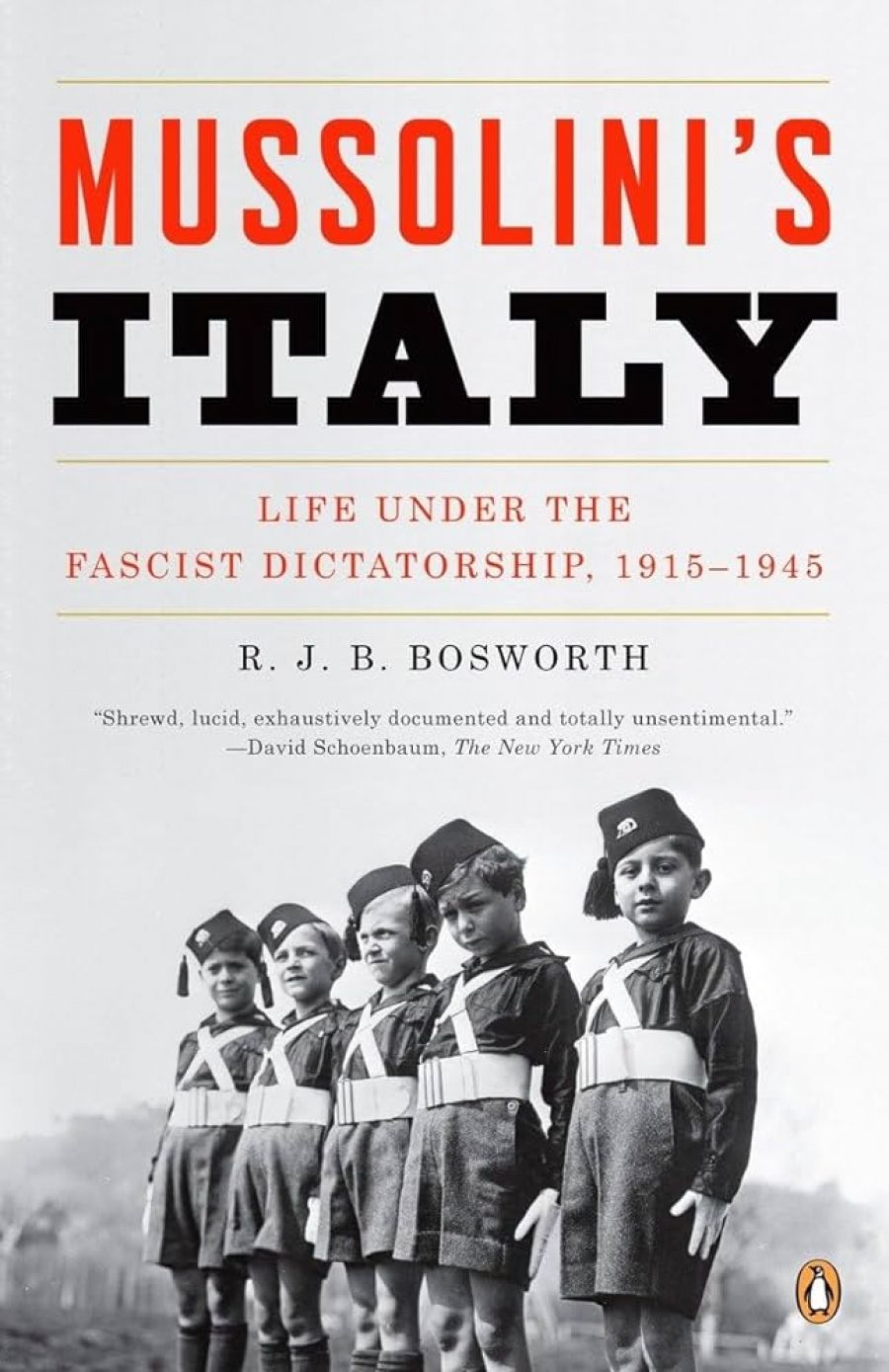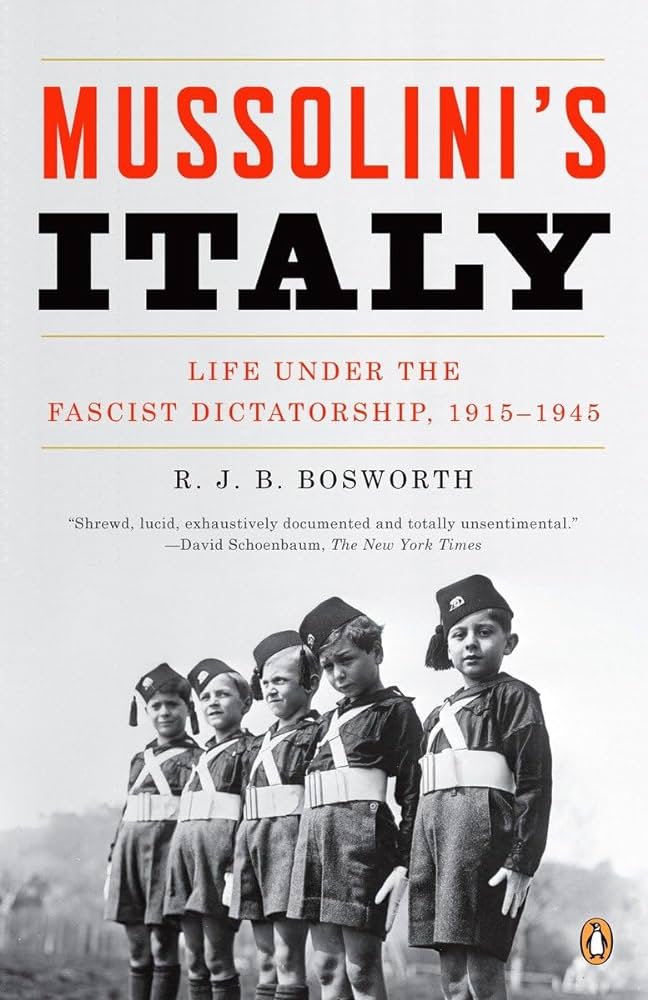
- Free Article: No
- Contents Category: History
- Review Article: Yes
- Article Title: Tinctured by fascism
- Online Only: No
- Custom Highlight Text:
One thing is certain: Mussolini would not like this book. Indeed, it is exactly the sort of writing that would rouse Il Duce’s ire. In the last disintegrating days before his ignominious end, when Mussolini realised that his erstwhile allies, the Germans, had outmanoeuvred him, that members of his inner circle were frantically making arrangements to flee Italy, and that partisan uprisings had set Lombardy and the Po Valley alight, the archbishop of Milan offered what was supposed to be a soothing observation: that Il Duce should take heart that he would be remembered by history. Enraged by this assurance, Mussolini declared: ‘History, don’t talk to me of history. I only believe in ancient history, in that which is written without passion and long afterwards.’
- Book 1 Title: Mussolini’s Italy
- Book 1 Subtitle: Life under the dictatorship 1915–1945
- Book 1 Biblio: Allen Lane, $59.95 hb, 692 pp, 0713996978
- Book 1 Cover Small (400 x 600):

- Book 1 Cover (800 x 1200):

Whatever Mussolini might think of this book, Richard Bosworth is a leading historian of modern Italy. The 584 pages of his biography Mussolini (2000) are a lively read; the present volume, longer again by more than a hundred pages, moves at a similarly bracing pace. What was notable about the biography was that the analysis privileged the context in which Mussolini functioned. Previous approaches, of which undoubtedly Il Duce would have approved, cast the Italian leader, Copernicus-like, as the sun around which the Italian planets revolved. Bosworth, however, was concerned with other questions altogether. He was curious to understand how a flawed, vulgar, oversexed provincial had managed to become the illustrious leader of Italy; and the combination of history and contingency that enabled a nobody from small-town Romagna to pull off this amazing stunt. The introduction to Mussolini’s Italy indicates that it was conceived as a sort of companion volume to the biography. It was prompted in answer to a reviewer’s question about ‘what was going on in the small towns and the provinces that encouraged Italians to accept the Italian dictatorship’. Pitched below the radar of high fascist politics, the book reconstructs the web of experiences of élite, bourgeois and poor Italians that constituted the thread and texture of political life in fascist Italy. It also demonstrates the ways in which Italians and foreigners continued to accept that fascist posturing and polemic signified a new form of social organisation, even though, over time, the fascist state came more and more to resemble the ramshackle régime it had replaced.
The great strength of this analysis is that it manages to depict the régime in a way that is never static. The author evokes the historical motion in the formation of the fascist state. From the inchoate and emergent nature of the early years, there is always a sense of a society in which other possibilities were present. From the factory occupations in the early 1920s and the jostling for power among the ras, to the attempt to fascisticise society in the middle years, and even during the tawdry last gasp of the Republic of Salò, the state and its leader were constantly forced to negotiate with the traditional institutions of the church and the monarchy, while also accommodating Mussolini’s adversaries. In a nutshell, the dictatorship managed this balancing act by combining the possibility of rewarding individual self-interest while ruthlessly applying social violence when required.
The dense political narrative in Mussolini’s Italy, told more or less chronologically, is studded with arresting vignettes. They show the multitudinous ways that individuals, families and bureaucrats played their cards – exactly as people always have – with the object of improving their own situations. In this case, though, it was against the backdrop of the Italian dictatorship with its capacity for surveillance, punishment and reward. These tales provide a highly nuanced view of how fascism treated Italians and, in turn, how they responded to the régime.
For example, one of the ‘Fascists of the First Hour’, whose party card was stamped with the desirable date of 1 January 1920, was the aristocrat Elisa Majer Rizzioli. Her early politics were nationalist. A lady-bountiful figure, she assisted impoverished military families and then, during the wars in Libya and World War I, donned a nurse’s uniform and went to the front. In the 1920s she jettisoned her husband to become part of the virile crowd in the fascist movement. In the end, she had founded what, in her comrades’ eyes, would have been the worthy organisation of the Association Against Exaggerated Luxury Among Women. Or there was the priest in Fiuli who resisted the merger of his Catholic scout troop with the fascist Balilla. Arrested and charged with promoting immorality among the local boy scouts, he argued spiritedly in his own defence that he had always worked to defeat bolshevism and, besides, if the court sent him away, there would be no one to care for his aged mother. Filial loyalty seems to have carried the day, and he was amnestied. Another case that came before the courts related to four friends in a hamlet in Piedmont who became rowdily drunk and began to sing the old songs of the village. These included the ‘Red Flag’, which brought swift reprisal. Or there is the story, close to Il Duce’s ménage, of Marcello Petacci, the brother of Mussolini’s mistress Claretta, who managed to importune his examiners and to wangle a pass in his medical finals.
Despite the appeal of these narratives, Bosworth has no time for the notion that Italian fascists remained ‘brava gente’. In his view, that claim has meant that the brutal aspects of the dictatorship have been passed over so that Italians as ‘nice people’ were permitted to differentiate themselves from Nazism and the vileness of a variety of interwar dictatorships. By contrast, Bosworth is astringent in highlighting the violence and meretriciousness of the Italian dictatorship. He emphasises that these propensities were held in common with other right-wing governments that were contemporaneous with Mussolini’s Italy. He points out, however, that the manifestations of racism in Italy were different in form and content from that in other places. In Germany, anti-Semitism was at the core of Nazism, while Jews up until 1938 had been highly integrated into Italian bourgeois society. But Italian racism was never non-existent; the objects of its commonest forms, as purveyed by the state and individuals across the nation, featured Ethiopians, Slovenes and southerners, the latter at least within the purview of those living in the country’s northern regions.
Bosworth is a political historian, iconoclastic rather than ideologically part of any camp. He tells us that he is sceptical about a ‘culturalist’ approach to Italian fascism, and he is no fan of the new histories that are more concerned with ritual and public spectacle than with violence and politics. Yet, for this reviewer at least, the most delightful parts of the book are those that would sit easily within high cultural history. There is a powerful deconstruction of the real significance of those familiar cinematic images of Mussolini’s ‘Balcony Empire’ as he addressed the ‘oceanic crowds’ mesmerised on the Piazza Venezia. The discussions of spectacle and timing provide deft cultural analysis. The régime unsuccessfully attempted to create a new fascist time and calendar that, in the spirit of the French Jacobins, would mark the dawning of a new Italian era. Similarly, the régime went to great lengths with fashion and uniforms and wished to create flags and anthems that would be appropriate in a modern fascist state. Inevitably, all these ventures went the way of the attempts to change ceremonial days and feste, whereby regional festivals on saint’s days and the high days on the fascist calendar came to overlap. The most successful new celebrations were those where traditional religious holidays provided the familiar space into which fascist ritual and polemic were poured. Bosworth lays out the complications that were faced when the state undertook a streamlining of the school curriculum and schoolbooks with a view to inculcating values that would bring Italian boys and girls to fascist adulthood. All of these endeavours, in the end, were forced to negotiate around Catholicism, the Church, deeply entrenched regionalism and the old style of Italian nationalism.
In the present university environment, where administrators chase the research dollar and cook up deals to hook the prizes in the national research stakes, Bosworth is hot property. The distinguished professor of modern history at the University of Western Australia, he has recently been inveigled across the water to divide his academic year between UWA and the University of Reading, Britain. His extraordinary output in a list of scholarly books in English and Italian would be an ornament on any vice-chancellor’s wish list. For many weeks, the biography of Mussolini sat high on the New York Times bestseller list. These days it can be read in the local language from Ballarat to Barcelona to Beijing. One can assume that Mussolini’s Italy will receive the same acclaim.
Nevertheless, Bosworth is a curious figure among high-rolling transnational academic celebrities. As he tells us in several of the introductions, he relishes undergraduate teach-ing, an anathema in the productivity stakes for the research quantum. And the strong authorial voice that guides the reader on the journey through Mussolini’s Italy is engagingly, often hilariously, Australian. For example, we are told that Count Ciano, the playboy who married Mussolini’s favourite daughter and became Italian foreign minister, was a ‘yuppie’. Among a series of graphic mini portraits of the great ras, the boyars and regional barons that surrounded Mussolini, we learn that many of them had their ‘snouts in whatever troughs were available’, and that Roberto Farinacci, in Cremona, used the violence of his ‘sidekicks’ to overawe the fascist locals. In Griffith, New South Wales, an elderly man remembers that the best thing about fascism in his youth was that the girls’ short skirts made it easier for the boys to look under them. There is, too, among a set of beguiling photographs of Italians and colonials, a troop of Melbourne children in 1936 carrying the flag of the Balilla, arms cheerfully raised in the Roman salute. As Bosworth tells it, this is a history of Italy ‘tinctured’ by fascism but, equally, ‘deeply coloured’ by other factors.


Comments powered by CComment